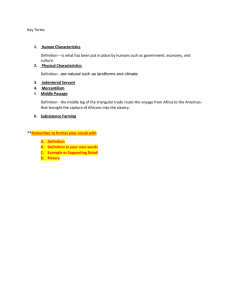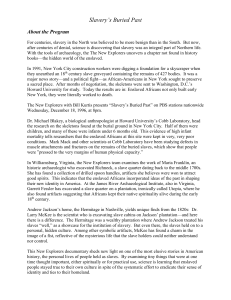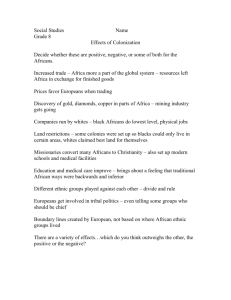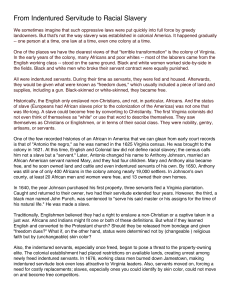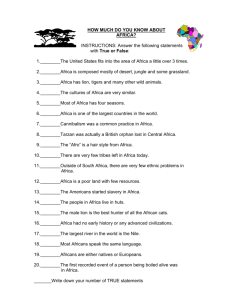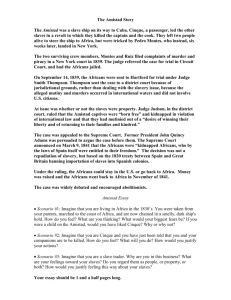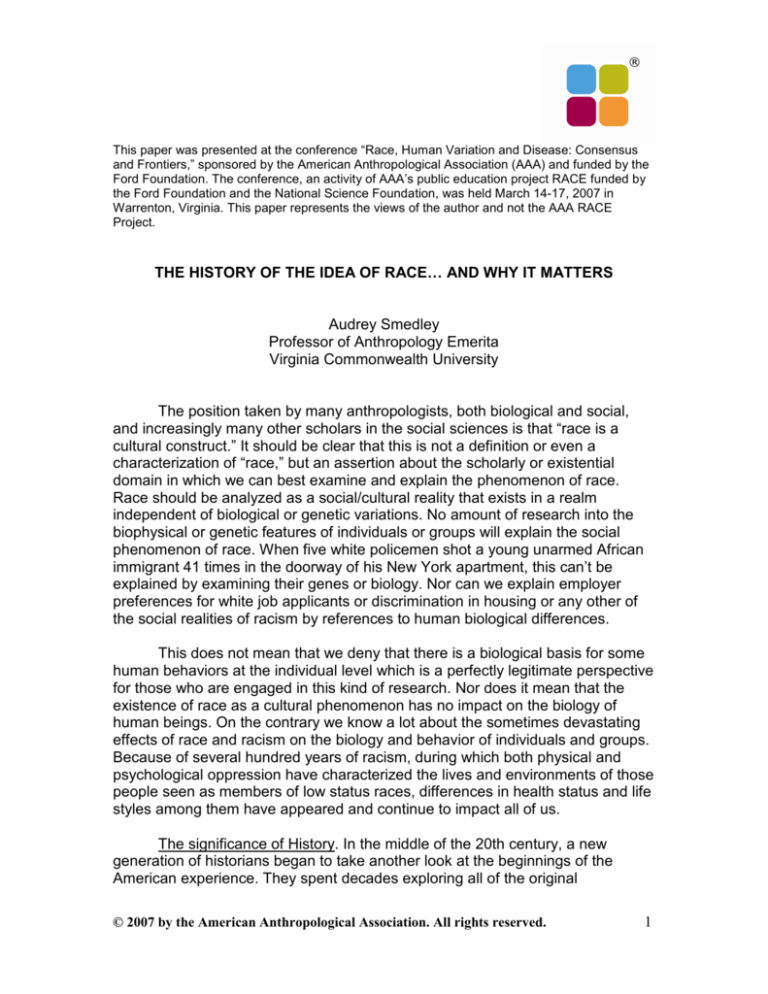
This paper was presented at the conference “Race, Human Variation and Disease: Consensus
and Frontiers,” sponsored by the American Anthropological Association (AAA) and funded by the
Ford Foundation. The conference, an activity of AAA’s public education project RACE funded by
the Ford Foundation and the National Science Foundation, was held March 14-17, 2007 in
Warrenton, Virginia. This paper represents the views of the author and not the AAA RACE
Project.
THE HISTORY OF THE IDEA OF RACE… AND WHY IT MATTERS
Audrey Smedley
Professor of Anthropology Emerita
Virginia Commonwealth University
The position taken by many anthropologists, both biological and social,
and increasingly many other scholars in the social sciences is that “race is a
cultural construct.” It should be clear that this is not a definition or even a
characterization of “race,” but an assertion about the scholarly or existential
domain in which we can best examine and explain the phenomenon of race.
Race should be analyzed as a social/cultural reality that exists in a realm
independent of biological or genetic variations. No amount of research into the
biophysical or genetic features of individuals or groups will explain the social
phenomenon of race. When five white policemen shot a young unarmed African
immigrant 41 times in the doorway of his New York apartment, this can’t be
explained by examining their genes or biology. Nor can we explain employer
preferences for white job applicants or discrimination in housing or any other of
the social realities of racism by references to human biological differences.
This does not mean that we deny that there is a biological basis for some
human behaviors at the individual level which is a perfectly legitimate perspective
for those who are engaged in this kind of research. Nor does it mean that the
existence of race as a cultural phenomenon has no impact on the biology of
human beings. On the contrary we know a lot about the sometimes devastating
effects of race and racism on the biology and behavior of individuals and groups.
Because of several hundred years of racism, during which both physical and
psychological oppression have characterized the lives and environments of those
people seen as members of low status races, differences in health status and life
styles among them have appeared and continue to impact all of us.
The significance of History. In the middle of the 20th century, a new
generation of historians began to take another look at the beginnings of the
American experience. They spent decades exploring all of the original
© 2007 by the American Anthropological Association. All rights reserved.
1
documents relating to the establishment of colonies in America. What these
scholars discovered was to transform the writing of American history forever.
Their research revealed that our 19th and 20th century ideas and beliefs about
races did not in fact exist in the 17th century. Race originated as a folk idea and
ideology about human differences; it was a social invention, not a product of
science. Historians have documented when, and to a great extent, how race as
an ideology came into our culture and our consciousness. This is the story that I
will briefly tell here. (One of the first of the publications and perhaps the one with
the greatest impact was a book by Edmund Morgan entitled, American Slavery,
American Freedom [1975]. It is the detailed story of Virginia, the first successful
colony. On its publication it was hailed as a classic that has inspired numerous
other historians.)
The establishment of Jamestown in Virginia by English colonists occurred
400 years ago this year, in 1607. From the beginning, Jamestown was a crude,
rough, and turbulent community of mostly young Englishmen who came to seek
their fortunes and return home. They planned to emulate the Spanish; to obtain
wealth by conquering and enslaving the native peoples, and forcing them to
produce gold and silver. However, the Indians didn’t take well to slavery; many
died of European diseases and others escaped to unknown territories. Also
there was no gold and silver immediately available; but settlers soon discovered
a crop, tobacco, whose trade would bring them wealth.
But growing and processing tobacco required very hard work. The
greatest problem the colonists constantly faced was lack of labor; many settlers
would not or could not do such intensive work. Within a decade, the colony
began to import indentured servants, mostly from England, and it was this pattern
of servitude that provided a model for the slavery that was to come later.
Servants were bought and sold, ill-fed, ill-clothed, and poorly-housed. They were
punished cruelly for petty crimes. Mortality was high, but the surplus poor
emigrating from England in the early 17th century had few choices. If they
survived the period of debenture, usually 4-7 years in the New World, they could
be set free, allowed to acquire land and servants, and to make their fortunes for
themselves. However, there were many degrees of servitude; and most did not
survive.
In 1619, the first Africans arrived. There has been some debate about
who they were, but we know that they had Spanish or Portuguese names and
were already familiar with European culture. In the US it is widely and popularly
believed that the colonists brought Africans to the New World as slaves from the
beginning and that Europeans were “naturally” prejudiced toward Africans
because of their physical characteristics, specifically dark skin. Historians now
hold that true slavery did not exist in the early decades of the English North
© 2007 by the American Anthropological Association. All rights reserved.
2
American colonies (see Allen 1997, Fredrickson 2002, E. Morgan 1975, P.
Morgan 1998, Parent, Jr. 2003, among others). Englishmen were unfamiliar with
the institution. They saw their society as a free one, based on free labor, and
believed that English laws had terminated all forms of slavery centuries before
their arrival in the Americas. But they were familiar with many forms of bond
servitude which they saw as unfree labor, and some men who purchased
headrights to laborers treated them as if they were slaves for life. Masters were
often brutal; they flogged servants for disobedience, or cut off their ears, or put
skewers through their tongues. But the settlers were also callous and cruel
toward one another. Often servants were called slaves, and a distinction
between servitude and slavery was not at all clear.
Consequently, the first Africans who arrived in Jamestown were not
initially or uniformly perceived as slaves (Parent 2003). They were assimilated
into the colony as laborers under varying contracts like those of Europeans.
Some Africans worked off their debts and became freedmen. A few ambitious
men obtained land and livestock, built substantial houses, married, and
established themselves as well-to-do planters. Some became entrepreneurs and
engaged in trading and other commercial activities and had business dealings on
an equal footing with whites. One famous family, that of Anthony Johnson and
his two sons owned more than 440 acres of land; they also had headrights for,
(that is, owned) three Africans, three Europeans and two Indians as servants.
They exercised the same rights as propertied Europeans. They participated in
the assembly, the governing body of the colony, voted, served on juries, and
socialized with white planters. Like their white counterparts, free black property
owners were often contemptuous of government, arrogant and insulting toward
those considered their social inferiors, assertive of their rights, and prone to
fighting. In fact, numerous court records provide clear evidence that these 17th
century Africans did not act differently from whites of the same social class.
Edmund Morgan wrote, “There is more than a little evidence that
Virginians during these years were ready to think of Negroes as members or
potential members of the community on the same terms as other men and to
demand of them the same standards of behavior. Black men and white serving
the same master worked, ate, and slept together, and together shared in
escapades, escapes, and punishments” (1975, 327). “It was common for
servants and slaves to run away together, steal hogs together, get drunk
together. It was not uncommon for them to make love together” (1975, 327).
No stigma was associated with what we today call intermarriages. Black
men servants often married white women servants. Records from one county
reveal that one fourth of the children born to European servant girls were mulatto
(Breen and Ennis 1980). Historian Anthony Parent (2003) notes that five out of
© 2007 by the American Anthropological Association. All rights reserved.
3
ten black men on the Eastern Shore were married to white women. One servant
girl declared to her master that she would rather marry a Negro slave on a
neighboring plantation than him with all of his property, and she did (P. Morgan
1998). Given the demographics, servant girls had their choice of men. One
white widow of a black farmer had no problem with remarrying, this time to a
white man. She later sued this second husband, accusing him of squandering
the property she had accumulated with her first husband (E. Morgan 1975, 334).
In another case, a black women servant sued successfully for her freedom and
then married the white lawyer who represented her in court (P. Morgan, 1998).
By mid-century, the colony was in a crisis. A few men from among the
earliest settlers had taken over most of the fertile land; they had established large
plantations and grew tobacco to make huge fortunes. Poor servants who
achieved their freedom found it difficult to acquire land. The freed poor and
servants, which now included Europeans, Africans, mulattoes, and a few Indians,
became unhappy with their lot and especially the corruption and abuse of power
on the part of wealthy men who ruled the colony. They threatened rebellions,
plundered their neighbors, showed contempt for colony leaders, and generated
unrest throughout the settlement.
In 1676, the most famous rebellion took place. Led by Nathaniel Bacon,
this uprising of thousands of poor workers was the first major threat to social
stability. The rebellion dissipated after the death of Bacon, but British royal
commissioners sent out to suppress the uprising realized that the population at
large had supported the rebellion and were “sullen and obstinate.” On one
occasion they faced a dissatisfied rabble of “400 African and 600 or 700
European bond laborers, chiefly Irish” (Allen 1994, 218). They soon recognized
the need for a stratagem to prevent such occurrences in the future and ensure
that a sufficient number of controlled laborers were made available to plantation
owners.
The decisions that the rulers of the colony made during the last decades
of the 17th century and the first quarter of the 18th century resulted in the
establishment of racial slavery. They began to pass a series of laws separating
out Africans and their descendants, restricting their rights and mobility, and
imposing a condition of permanent slavery on them. Africans were now being
brought directly from Africa. They were different from earlier Africans in that they
were heathens, that is, not Christians, and were unfamiliar with European
languages, customs, and traditions. Some colony leaders began to argue that
Africans had no rights under British laws and therefore could be subject to forced
labor with impunity. After 1672, British ships entered the slave trade and the
numbers of people shipped directly across the Atlantic greatly increased.
© 2007 by the American Anthropological Association. All rights reserved.
4
There were critical reasons for the preference for Africans. As early as the
1630s, planters had expressed a desire for African laborers (“If only we had
some Africans!”). Records of plantation owners in the Caribbean and in the
colonies of Virginia and Maryland reveal the fact that Africans were initially
considered a civilized and docile people who had knowledge of and experience
with tropical cultivation. They were accustomed to discipline, one of the
hallmarks of civilized behavior, as well as working cooperatively in groups. They
knew how to grow corn, tobacco, sugar cane, and cotton in their native lands;
these crops were unknown in Europe. And many Africans had knowledge of
metal work, carpentry, cattle-keeping, brick-making, weaving, leather tanning,
and many other skills. Colonists soon realized that without Africans, their
enterprises would fail. They often wrote, “We cannot survive without Africans!”
A good example is the history of the colony of Georgia, in the mid-18th
century. This colony was founded (1732) by followers of John Wesley (founder
of Methodism) with the objective of settling here poor people from Europe. The
founders and organizers had an anti-slavery policy and Georgia became the first
non-slaveholding colony. But the experiment failed; the settlers endured hunger,
disease, poverty, and many deaths. They soon petitioned the trustees to alter the
policy and to allow slaves. They argued that they could not survive without
African slaves. Nearly twenty years after the founding, the act prohibiting slavery
was repealed and Georgia began to prosper (see Smedley 1999, 2007).
Although there were more Irish slaves in the Caribbean Isles than
Africans, those peoples captured in wars with the English, knew nothing about
tropical agriculture and were seen as “savages,” (they had a “dangerous nature”)
(see Smedley 2007). They often ran away to join their co-religionists, the catholic
Spanish, and were considered a “rebellious lot.” Historian Leonard Liggio, quoted
from one letter sent to traders by a planter, “Don’t send us any more Irish; send
us some Africans, for the Africans are civilized and the Irish are not” (1976, 8).
In contrast to Indians, Africans also had natural immunities to Old World
diseases. European colonists recognized that Africans lived longer and were able
to produce more than Europeans who had a high mortality rate. Moreover,
Africans were in a strange land with no powerful allies and, unlike the Indians,
could not escape to familiar territories. They were the most vulnerable of all the
peoples of the Americas.
Sources of English servants began to decline in the latter part of the 17th
century, as jobs became available at home. The slave trade to Africa increased
as internal warfare in Africa made more and more people available for
enslavement. Leaders of the colonies, all large planters, had two objectives: to
impose effective social controls over the population and provide themselves with
© 2007 by the American Anthropological Association. All rights reserved.
5
cheap and easily controlled workers. They readily perceived that they could use
the differing physical characteristics of the population to divide them and
demarcate some for permanent slavery. Historian Anthony Parent (2003) argues
that a powerful planter class, acting to further its own economic interests,
deliberately brought a new form of servitude, racial slavery to Virginia over the
period of 1690-1723. In this period, hundreds of laws were passed restricting the
rights of Africans and their descendents. By 1723, even free Negroes were
prohibited from voting.
Colonial leaders were also doing something else; they were laying the
basis for the invention of race and racial identities. They began to homogenize all
Europeans, regardless of ethnicity, status, or social class, into a new category.
The first time the term “White,” rather than “Christian” or their ethnic names
(English, Irish, Scots, Portuguese, German, Spanish, Swede) appeared in the
public record was seen in a law passed in 1691 that prohibited the marriage of
Europeans with Negroes, Indians, and mulattoes (Smedley 2007, 118). A clearly
separated category of Negroes as slaves allowed newly freed European servants
opportunities to realize their ambitions and to identify common interests with the
wealthy and powerful. Laws were passed offering material advantages and social
privileges to poor whites. In this way, colony leaders consciously contrived a
social control mechanism to prevent the unification of the working poor (Allen
1997). Physical features became markers of racial (social) status, as Virginia’s
governor William Gooch asserted, the assembly sought to “fix a perpetual Brand
upon Free Negroes and Mulattos” (Allen 1997, 242).
However, the earliest rationale for racial slavery was not differences in
physical features, but the identification of Africans as uncivilized heathens. The
first “savages” that English had created in their minds were the “wild Irish.” In the
late 16th century, after centuries of conflict and brutal warfare with the Irish,
Queen Elizabeth declared that the Irish were natural “savages” incapable of
civilization. Such attitudes generated extreme hatred of the Irish that has
continued into the 21st century. In fact, the Elizabethans came very near to
racializing the Irish, and in the 18th century the term “race” was imposed on the
Irish.
Native Americans became “savages” when they resisted English
appropriation of their lands, but this image began to change in the late 18th cent.
Now, early in the 18th century, by reducing Africans to permanent slavery,
prohibiting owners from freeing slaves, prohibiting their education and training,
the English invented a new savage. From the early 18th century on, negative
characterizations of Africans formed part of a new rationalization for
enslavement. These became the stereotypes of races and race differences that
we inherited in the 19h and 20th centuries. What colony leaders were doing was
© 2007 by the American Anthropological Association. All rights reserved.
6
establishing unequal groups and imposing different social meanings on them. As
they were creating the institutional and behavioral aspects of slavery, the
colonists were simultaneously structuring the ideological components of race.
They exaggerated human differences and even invented some that could not be
sustained empirically, such as the belief that Negroes had black brains and
blood.
By the end of the 18th century, during the Revolutionary era, a great
debate over the nature of “the Negro” had developed. Anti-slavery forces,
particularly in Europe, castigated the leaders of the American Revolution for
advocating freedom, yet holding more than two million people enslaved. In
response, pro-slavery proponents developed an ideology about human group
differences that dehumanized “the Negro” and demoted him to a status closer to
the apes. Thomas Jefferson was the first to proclaim that we should leave the
question of the Negro’s status in nature to science, which was just beginning to
emerge as a separate and distinct institution in Western culture. From the last
decade of the 18th century on, the writings of learned men appeared to proclaim
the natural inferiority of blacks.
In the 1860s, slavery ended, but “race” as social status and the basis of
our human identities remained. Race ideology proclaimed the existence of
separate, distinct, and exclusive groups that were made unequal by God or
nature. African-Americans, the most inferior, were at the bottom of the hierarchy,
European whites (some of them) were at the top. Each race was thought to have
distinct physical and behavioral traits that were inherited “in the blood,” and
passed on to their children. Thus, we have the continuing stereotype of AfricanAmericans as lacking in intelligence, lazy, overly-sexed, loud, irrational, musical,
emotional, and superstitious. Finally, it was believed that these race differences
could not be transcended or transformed (see Smedley 2007).
In the 19th century, “science” using techniques of measuring various
aspects of the human body, sought to affirm the differences between blacks and
whites and to justify the retention of phenotypically-based separate and exclusive
groups. In the 20th and 21st centuries, race scientists turned to IQ tests and the
new measure of human differences became primarily “intelligence.” In the 21st
century, race scientists persist in promoting these supposed heritable
characteristics of different races (see Smedley 2007).
The legacy of Race. This is the legacy about how North American
colonists constructed human differences, establishing a hierarchy of “races” for
social, economic, and political purposes. There are many benefits to knowing this
history. We have inherited a legacy of enslavement without fully understanding
the realities of the 17th century world in part because most histories taught in the
© 2007 by the American Anthropological Association. All rights reserved.
7
19th and 20th centuries contained negative stereotypes about who our African
ancestors were. Modern historians have provided a corrective to such distorted
history by restoring accurate accounts of events and their causes, especially the
role of Africans in the making of this country.
Knowing the broader context in which our ideas and beliefs evolved gives
us a better understanding of who we are as human beings. Most importantly, it
forces us to confront the reality of race. There is a passage in the Bible that says
“You shall know the truth, and the truth shall set you free.” Race is like a vise
that constricts our spirits and damages our psyches. I think Thomas Jefferson
understood this, despite his ambivalence and apparent moral duplicity, when he
wrote about the damages done to white children by the presence of slavery:
“The whole commerce between master and slave is a perpetual exercise of the
most boisterous passions, the most unremitting despotism on the one part, and
degrading submissions on the other. Our children see this, and learn to imitate
it…. From his cradle to his grave he is learning to do what he sees others do….
The parent storms, the child looks on, catches the lineaments of wrath, puts on
the same airs in the circle of smaller slaves, gives a loose to his worst of
passions, and thus nursed, educated, and daily exercised in tyranny, cannot but
be stamped by it with odious peculiarities. The man must be a prodigy who can
retain his manners and morals undepraved by such circumstances” (Jefferson,
Notes on the State of Virginia [1785] 1955, 346). (Jefferson was very much
aware of these terrible consequences; two of his grandchildren beat a slave to
death for breaking a cup!)
Both the high-status racial whites and the low-status races, especially
blacks and Indians, have been scarred in their daily lives by the racial images to
which we all have been conditioned. Knowing the truth about our history will help
to free us from the beliefs and attitudes about human differences that were
deeply embedded in our culture with the invention of “race” and “races.”
Finally, freedom from the lived experiences of racism, that so acutely
damages especially young African-Americans, may help to transform our entire
society. By expanding freedom and opening up access to cultural knowledge for
all people, it may well be that we will come closer to the ideals of equality and
opportunity.
References:
Allen, Theodore W.
1994 The Invention of the White Race. Vol. 1. London: Verso
© 2007 by the American Anthropological Association. All rights reserved.
8
Allen, Theodore W.
1997 The Invention of the White Race. Vol. 2. London: Verso.
Breene, Thomas K. and Keith Innes
1980 Myne Owne Ground. Oxford: Oxford University Press.
Fredrickson, George M.
2002 Racism: A Short History. Princeton: Princeton University Press.
Jefferson, Thomas.
[1785] 1955 Notes on the State of Virginia. Ed. by W. Peden. Chapel Hill:
University of North Carolina Press.
Liggio, Leonard P.
1976 “English Origins of Early American Racism.” Radical History Review 3,
no. 1:1-36.
Morgan, Edmund
1975 American Slavery, American Freedom. New York: W. W. Norton.
Morgan, Philip D.
1998 Slave Counterpoint: Black Culture in the 18th Century Chesapeake &
Lowcountry. Chapel Hill: University of North Carolina Press.
Parent, Anthony S. Jr.
2003 Foul Means: The Formation of Slave Society in Virginia, 1660-1740.
Chapel Hill: University of North Carolina Press.
Smedley, Audrey.
2007 Race in North America: Origin and Evolution of a Worldview. Third
Edition. Boulder, CO: Westview Press.
© 2007 by the American Anthropological Association. All rights reserved.
9

